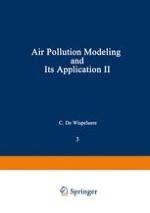1983 | OriginalPaper | Chapter
A Finite Element Flow Model over the Alsace Plain
Authors : P. Racher, F. X. Le Dimet, J. F. Roussel, P. Rosset, P. Mery
Published in: Air Pollution Modeling and Its Application II
Publisher: Springer US
Included in: Professional Book Archive
Activate our intelligent search to find suitable subject content or patents.
Select sections of text to find matching patents with Artificial Intelligence. powered by
Select sections of text to find additional relevant content using AI-assisted search. powered by
In a previous paper (Racher et al.,1), we have applied to the mid-Rhine valley a mass-consistent wind field model based on a variational technique for solving the incompressible continuity equation originally developed by Sherman2. Taking advantage of this variational approach which directly inserts the collected experimental information into the integration procedure itself, we depart from reference 2 mainly on three points. First, we use a terrain-following vertical coordinate (σ-coordinate), thus avoiding the problems of intersecting the topography. Secondly, as will be seen in next paragraph, we have generalized the boundary conditions so as to include the effects of inflow and outflow across the boundaries. And thirdly, we have designed an initialization procedure (Roussel3, Mac Lain4) which aims at retaining most of the meteorological information collected on an irregularly-distributed network of stations. This is an important point which deserves further discussion, since the final relaxed solution is rather strongly dependent upon the initial first-guess wind field. Our initialization scheme avoids too much smoothing in the measured wind field through local expansion of the solution for each horizontal wind component in terms of a polynomial basis function within every triangle obtained by joining the stations. The values thus obtained are then redistributed over the grid points of a regular grid covering the domain under study. In doing so, we retain some of the fine-scale atmospheric structures reflected into the local wind measurements. These structures involve radiative and thermal as well as dynamic effects at many spatial and temporal scales: the adjustment implied through the continuity equation bears only upon the wind components, though accomodating in part the non-dynamic effects which contribute to them. One can assume that a larger number of constraint equations would lead to a reduction in the crucial role played by the initialization procedure.
